Remote jobs data shows that distributed hiring is the new normal for many companies. Remote roles, hybrid jobs, work from anywhere benefits, and remote perks are all increasingly popular with candidates. So much so that companies are working to make non-remote jobs more attractive.
We were curious about the impact remote work is having on the hiring landscape as a whole. So we analyzed job posts and hiring outcomes from 2019 onwards to find out. Our dataset includes 30 million real-world job posts (i.e., actual jobs). The data comes from over 10,000 employers and 122 different applicant tracking systems (e.g., Greenhouse, Workday, and SmartRecruiters).
If you’re curious what other companies are doing now and which distributed hiring trends you should follow, this remote jobs data may help. Here are the highlights:
Distributed hiring trends
- The distributed hiring era is here to stay.
- Remote jobs are 5x pre-pandemic levels.
- Remote jobs attract 2.2x more candidates than non-remote jobs.
- Remote jobs attract 2.2x more women than non-remote jobs.
- Remote jobs attract 125% larger inbound candidate pools than non-remote jobs.
- New types of jobs are emerging – hybrid jobs (a mix of remote and onsite).
- There’s a lot of confusion about what hybrid jobs are.
- Nearly 50% of companies had no remote or hybrid roles in 2019. Today, that percentage is down to 15%.
- Remote jobs are offering more remote-specific perks and benefits.
- Bonuses are growing more common for onsite jobs.
- Fair chance hiring (for applicants with prior convictions) is on the rise.
- Remote jobs are more popular in North America than other global regions.
- Startups and unicorns are adapting fastest to distributed hiring. (Startups: privately owned, venture-backed. Unicorns: privately owned, $1 billion valuation.)
- Work from anywhere is growing in popularity.
- Degree requirements are on the decline.
How this remote jobs data is unique
First, the Datapeople R&D team collected job listing data directly from over 10,000 companies and analyzed them for trends. We’re the only ones with access to this data, so our findings are unique.
Second, we used our own internal research and language models to deconstruct and categorize the data. Most of the market reports you read are based on government data. They use job titles (which can be deceiving) and basic company information as the basis for their analyses. Datapeople goes much deeper than that.
We annotate job outcomes data by job type, company, applicant, and application sources. Our language models enable us to deconstruct each job description by language attributes, job type, skills, and qualifications. And we look at job location and multiple employer attributes, not just company name.
All of that is to say that this remote jobs data report goes much deeper than the occupational and industry classifications available in government data. It’s how the Datapeople R&D team is able to identify certain distributed hiring trends. And how we can offer tips for recruiting remote and non-remote jobs alike.
Okay, to the results!
1. The distributed hiring era is here to stay
There’s no question the Covid-19 pandemic accelerated the trend towards remote work. Companies had to transition overnight to what many thought would be a temporary measure. But they soon discovered that employees love to work from home and don’t really want to go back to the office.
Even after the easing of public health restrictions, the massive candidate preference for remote work isn’t waning. In fact, our remote jobs data shows that it’s increasing quarter over quarter in 2022. Candidates love remote jobs, and companies are having to learn how to manage them on the fly (e.g., how to correctly title remote versus hybrid jobs).
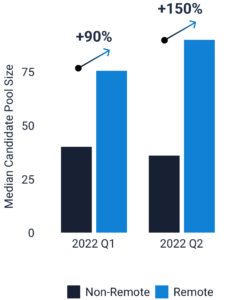
2. Remote jobs are 5x pre-pandemic levels
Remote jobs are quickly becoming a permanent feature of work life. In 2019, about 2% of professional jobs were remote, according to our remote jobs data. Today, they have grown to 10% and continue to grow dramatically.

However, our remote jobs data shows that the distribution of remote and hybrid jobs isn’t balanced across all job types and seniority levels. Tech roles in the US, for example, are twice as likely to be remote than hybrid, while mid-level and senior roles are twice as likely as junior roles to be remote.

3. Remote jobs attract 2.2x more candidates than non-remote jobs
According to our remote jobs data, remote roles are attracting 120% larger candidate pools than non-remote jobs across all types of jobs and seniority levels. Most of these candidates are coming from inbound recruiting rather than sourcing or prospecting.
Remote jobs started getting larger candidate pools during the pandemic, but they didn’t decrease in size after Covid restrictions eased. In fact, they got bigger. In 2019 and 2020, remote roles attracted 30% larger candidate pools than non-remote jobs. That percentage jumped to 140% in 2021 and is around 120% for 2022.
Given the growing popularity of remote and hybrid jobs, it’s perhaps not surprising that they kept their momentum after Covid restrictions eased. This is another sign of the shift that’s taking place around remote work.

4. Remote jobs attract 2.2x more women than non-remote jobs
Remote roles are attracting 120% more female candidates across all role types and seniority levels in 2022, according to our remote jobs data. There could be many reasons for this, but anecdotal evidence and surveys offer one strong possibility. Women provide a disproportionate amount of the caregiving in our societies, so remote work may be more attractive to them.

Indeed’s Hiring Lab found that, in February 2022, 43% of jobless men searched for work while only 38% of jobless women did. Among men and women who didn’t look for work, women cited childcare as the reason they weren’t looking twice as much as men. And women sought remote jobs way more than men.
“The pandemic’s initial labor market damage was vast, and women bore the brunt of it. Since then, recovery has been robust but often uneven along gender lines. In a tight labor market where employers are wondering where the workers are, the question of how to draw jobless women back into the workforce has been in the spotlight.”
Hiring Lab’s Job Search Survey
5. Remote jobs attract bigger inbound candidate pools
Our data shows that remote roles of all types and experience levels are attracting 125% larger inbound candidate pools than non-remote jobs. Administrative and go-to-market roles are attracting around twice as many inbound candidates. Tech jobs are attracting about one and a half times as many inbound candidates, while other professional roles are attracting three times as many.
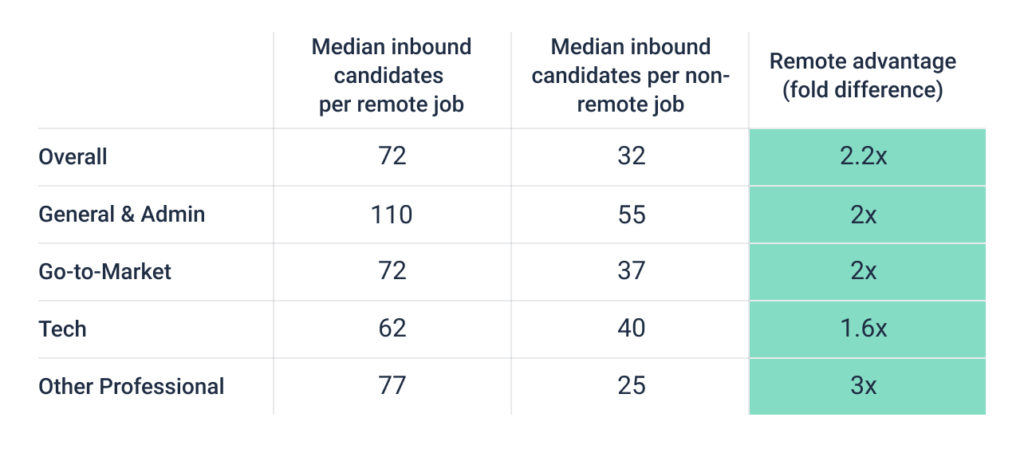
Inbound candidates are coming mostly from organic sources such as company career sites and online job boards like Indeed. In a previous study, the Datapeople R&D team investigated post-pandemic recruiting trends in the tech industry. We found that most applicants to tech jobs – 86% of them, actually – come from organic sources. Not only that, but 85% of female applicants to tech jobs apply through organic sources.
Organic sourcing is the heart of inbound recruiting and the most equitable way to source candidates. While inorganic sources such as prospecting lists and referral programs only invite certain job seekers, organic sources invite all job seekers with internet access.
6. New roles of the distributed hiring era – hybrid jobs
Before 2019, jobs that merged remote work and onsite work weren’t really a thing. But jobs that combine work from home with regular trips into the office have grown exponentially over the last two years. They now represent about 6% of professional roles.
Hybrid jobs can include work from home most of the time or only some of the time. Maybe someone has to go into the office a few days per week or maybe they just have to show up at a quarterly onsite meeting. Employers don’t necessarily define their jobs as hybrid, but some (e.g., Apple and GM) have been pioneering this type of arrangement.
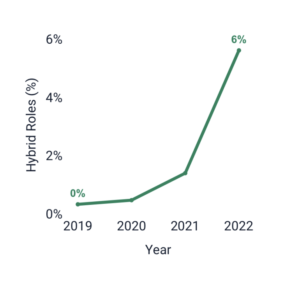
7. There’s a lot of confusion about what hybrid jobs are
Hybrid jobs aren’t all alike. And because they’re so new and varied (e.g., mostly remote versus mostly onsite), companies and job seekers are confused about them. With good reason.
In our remote jobs data, the Datapeople R&D team found that some postings describe what are actually hybrid jobs as “remote.” Whether inadvertently or in an effort to make the job more appealing, they overstate the flexibility of hybrid jobs. Or they use “remote” in the title but “hybrid” in the job post or list the role as “full-time remote but with two days in the office.” Or they say one thing while describing the job (e.g., “based in our Springfield office”) but another while describing perks (e.g., “flexible work from home policy”). This can confuse (or even annoy) job seekers.
8. Nearly 50% of companies had no remote or hybrid jobs in 2019. Today it’s only 15%.
Only half of all companies offered either remote or hybrid jobs in 2019, but the vast majority of companies offer them today. About 50% of companies currently offer remote roles while about 30% offer hybrid jobs.
Of course the Covid-19 pandemic contributed greatly to the shift from onsite jobs to remote and hybrid jobs. The pandemic also spurred the sudden rise of remote-first companies (those with over 50% remote jobs), which have grown 10x since 2019 from 2% of companies to nearly 27%.

9. Remote perks and benefits are on the rise
Our data shows that remote perks and benefits are rising along with the number of remote and hybrid jobs. Employers are adapting by offering perks and benefits that suit the way people now work.
Home office stipends have more than doubled since 2019, with 4% of companies mentioning them in job posts (5% for startups). At the same time, commuter and food (free in-office meals and snacks) benefits are decreasing dramatically. Meanwhile, the work-from-anywhere perk is gaining popularity, particularly in the UK and Europe (more on that below).

10. Bonuses are growing more common for non-remote jobs
Bonuses are increasing, according to the remote jobs data. In fact, 4x as many job posts mention bonuses today than in 2019, although the types of jobs and bonuses vary.
Sign-on bonuses are increasingly popular among frontline roles (i.e., onsite jobs like nurses and warehouse supervisors), while other bonuses (e.g., retention, merit-based) are popular with professional roles. Health and production roles are seeing a significant increase in all bonuses, while warehouse roles are only seeing an increase in sign-on bonuses.

11. Fair chance hiring is on the rise
Fair chance hiring, or second chance hiring, encourages candidates with arrests or convictions to apply. Although California has had fair chance hiring laws since 2018, the pandemic catalyzed the movement.
Our data shows that fair chance hiring mentions appear in 7% of jobs in 2022, up from less than 1% before the pandemic. Fair chance hiring has grown proportionally in the retail and healthcare sectors, and it’s up by 50% in professional roles. Remote roles are also contributing to the increase.
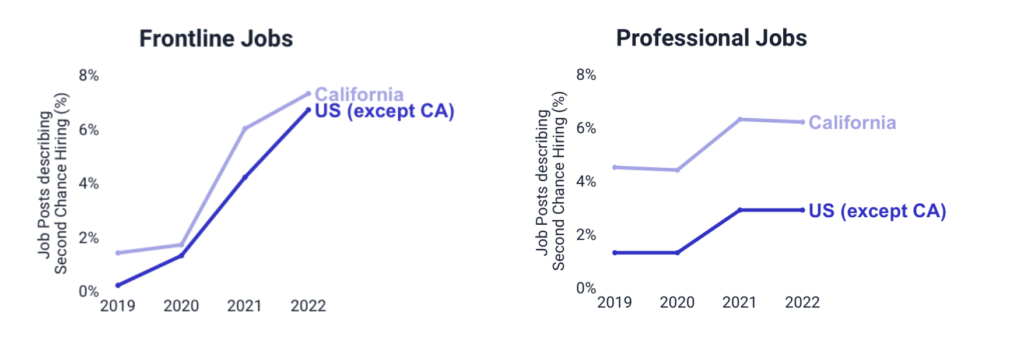
12. Remote jobs are more popular in North America
Remote roles account for almost 1 in 6 jobs overall in the US and Canada, while they account for 1 in 10 jobs in the UK and Europe. They account for 1 in 7 professional jobs in the US and 1 in 10 professional jobs in Canada. Remote roles are more popular in the UK than in continental Europe, accounting for 8% and 6% of professional jobs, respectively.

13. Startups and unicorns are adapting fastest to distributed hiring
Startups and unicorns were among the fastest to adapt during the pandemic, according to our remote jobs data. We define startups as early-stage, privately held companies that have raised a series of (often venture) funding. Unicorns are privately held companies that have reached a $1 billion valuation (e.g., GitLab, DataRobot, Instacart). In 2019, 53% of startups and 63% of unicorns supported remote work. Today, over 90% do.

14. Work from anywhere is growing in popularity
Work from anywhere is a new perk intended to give people in onsite jobs a taste of remote work. Work-from-anywhere arrangements enable people to work where they want for a limited time – typically between three to six weeks but also for longer periods in some cases.
Perhaps obviously, work from anywhere is most common for onsite jobs. It’s also more popular in the UK and Europe than in North America. The language around it usually includes mentions of extended vacations or travel abroad.
15. Degree requirements are on the decline
An unprecedented tightening of the labor market has forced a lot of employers to shake things up, as we described in our 2022 report on tech recruiting trends. Many have responded by reducing degree requirements and professional certifications. They continue to do so.
Degree requirements are down across the board from 2021 to 2022, for both remote and onsite jobs. In some frontline roles (e.g., production and facilities roles), our remote jobs data shows a decrease in the proportion of roles requiring degrees of any kind. In professional roles, the data shows decreases in advanced degrees (i.e., master’s, MBAs, PhDs) and professional certifications.
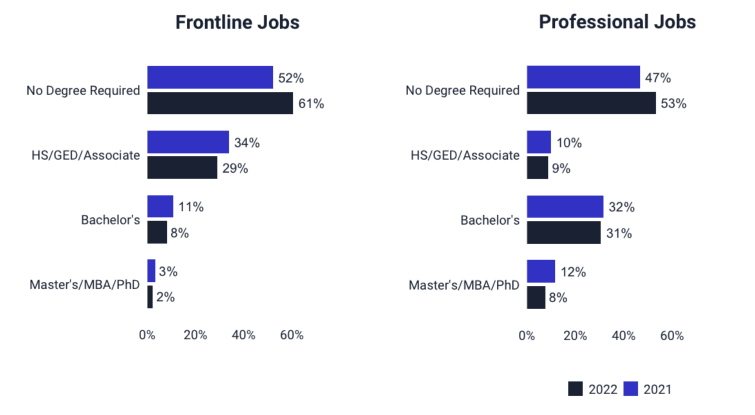
Remote jobs data in the distributed hiring era
Our remote jobs data shows that remote work is wildly popular, attracting more applicants, women, and inbound candidates overall. And remote jobs are up 5x since the pandemic, which means distributed hiring is here to stay.
These 15 data points are just the highlights of a much larger report from the Datapeople R&D team. If you’d like to dive deeper into remote jobs data in the distributed hiring era, you can also read our full report: Hiring in a Distributed World.
